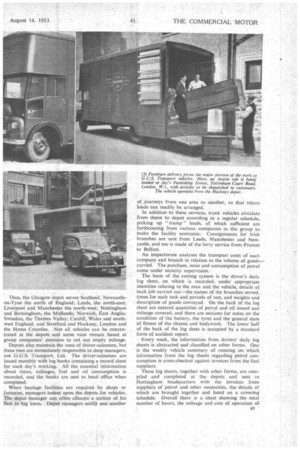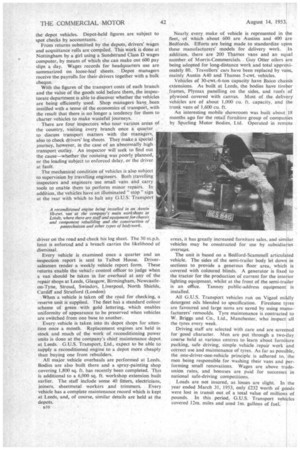40 C Unified • in Six Years
Page 42

Page 43

Page 44

If you've noticed an error in this article please click here to report it so we can fix it.
By Alan Smitt flow the Individual Trans,
,T
of the Constituent Co pa
• Great Universal Stor s 6 been Amalgamated into ( age Undertaking to Substantial Reductions in Costs and Running SIX years ago, the Great Universal Stores, Ltd., entrusted Mr. E. W. Scrace with the task of amalgamating the group's various road transport units to achieve higher •operating efficiency. Today, a fleet which stands among the largest in the country has been created.
The G.U.S. organization is mainly 'engaged in the retail, distribution distribution of all classes of wearing apparel, furniture and household goods through some 800 shops, depots and warehouses in the United Kingdom. In most areas, goods are delivered to customers by van. The company also have interests in various factories which supply part of their-requirements, particularly furniture.
Each company made their arrangements for transport, using either C-licence vans or hired vehicles, and it was to eliminate waste in such an unco-ordinated pattern, but to retain the service that was afforded, that G.U.S. Transport, Ltd., were formed, with headquarters at Talbot House, Nottingham, as-the. non-profit-making transport service company for the group.
G.U.S. Transport, Ltd., with Mr. Scrace as managing director, commenced by taking over seven vehicles of a furniture group. These formed a nucleus around which other vehicles were gradually acquired in pace with the expansion of the company's physical administrative capacity to do so. Last month, the stage was reached where 40 C licences had been combined into one and the company have control over some 1,500 vehicles.
Benefits of the new-system soon became apparent and savings in transport costs were realized, and the desire to participate in the transport pool grew. It was then found necessary to split the country into strategic zones and establish depotsin each at which to base fleets of vehicles to serve the needs of individual members of the . group in those areas.
B8 Thus, the Glasgow depot serves Scotland; Newcastleon-Tyne the north of England; Leeds, the north-east; Liverpool and Manchester the north-west; Nottingham and Birmingham, the Midlands; Norwich, East Anglia; Swindon, the Thanes Valley; Cardiff, Wales and southwest England; and Stratford and Hackney, London and the Home Counties. Not all vehicles can be concentrated at the depots and some vans remain hased at group companies' premises to cut out empty mileage.
Depots also maintain the vans of driver-salesmen, but these men are immediately responsible to shop managers, not G.U.S. Transport, Ltd. The driver-salesmen are issued monthly with log books containing a record sheet for each day's working. All the essential information about times, mileages, fuel and oil consumption is recorded, and the books are sent to head dffice when completed.
When haulage facilities are required by shops or factories, managers indent upon the depots for vehicles. The depot manager can often allocate a section of his fleet to big users. Depotltnanagers notify one another of ;journeys from one area to another, so that return loads can readily be arranged.
In addition to these services, trunk vehicles circulate from depot to depot according to a regular schedule, picking up " tramp " loads, of which sufficient are forthcoming from various companies in the group to make the facility economic. Consignments for Irish branches are sent from Leeds, Manchester and Newcastle, and use is made of the ferry service from Preston to Belfast.
An insPectorate analyses the transport costs of each company and branch in relation to the volume of goods-. carried. The purchase, issue and consumption of petrol come under security supervision.
The basis of the costing system is the driver's daily log sheet, on which is recorded, under appropriate identities relating to the man and the vehicle, details of each job carried out—the names of the branches served, times for each task and periods of rest, and weights and description of goods conveyed. On the back of the log sheet are entered quantities of petrol and oil issued and mileage covered, and there are sections for notes on the condition of the battery, the tyres and the general state of fitness of the chassis and bodywork. The lower half of the back of the log sheet is occupied by a standard form of accident report.
Every week, the information from drivers' daily log sheets is abstracted and classified on other forms. One is the weekly vehicle summary of running on which information from the log sheets regarding petrol consumption is cross-checked against invoices from the fuel suppliers.
These log sheets, together with other forms, are compiled and completed at the depots and sent to Nottingham headquarters with the invoices from suppliers of petrol and other necessities, the details of which are brought together and listed on a covering schedule. Overall there is a sheet showing the total number of hours, the mileage and cost of operation of the depot vehicles. Depot-held figures are subject to spot checks by accountants. From returns submitted by the depots, drivers' wages and acquittance rolls are compiled. This work is done at Nottingham by a girl using a Sundstrand Class D wages computer, by means of which she can make out 600 pay slips a day. Wages records for headquarters use are summarized on loose-leaf sheets. Depot managers receive the payrolls for their drivers together with a bulk cheque. With the figures of the transport costs of each branch and the value of the goods sold .before them, the inspec torate department is able to discover whether the vehicles are being efficiently used. Shop managers have, been instilled with a sense Of the economics of transport, with the result that there is no longer a tendency for them to charter vehicles to make wasteful journeys.
There are four inspectors who tour various areas of the country, visiting every, branch once a quarter
to discuss transport matters with the Managers, also to check drivers' log sheets. They make a Special-, journey, however, in the case of an abnormally high
transport outlay. An inspector will seek to find out the cause—whether the routeing was poorly planned, or the loading subject to enforced delay, or the driver at fault. , The mechanical condition of vehicles is also subject to supervision by travelling engineers. Both &aliening inspectors and engineers use small vans and carry tools to enable them to, perform minor repairs. In addition,.the'vehieles have an illuininated " stop " sign at the rear with which to halt any GIL& Transport driver on the road and check his log sheet. The 30 m.p.h. limit is enforced and a breach carries the likelihood of dismissal.
Every vehicle is examined once a quarter and an inspection report is. sent to Talbot House. Driversalesmen render a weekly vehicle report form. These returns enable the vehicl control officer to judge when a van should be taken in for overhaul at any of the repair shops at Leeds, Glasgow, Birmingham, Newcastleon-Tyne, Stroud, Swindon, Liverpool, North Shields, Cardiff and Stratford (London) When a vehicle is taken off the road for checking, a reserve unit is supplied. The fleet has a standard colour• scheme of green with gold lettering, which enables uniformity of appearance to be preserved when vehicles are switched from one base to another.
Every vehicle is taken into its depot shops for attention once a month. Replacement engines are held in stock and much of the work of reconditioning power units is done at the company's chief maintenance depot at Leeds. G.U.S. Transport, Ltd., expect to be able to supply a reconditioned engine to a depot more cheaply than buying one from rebuilders.
All major vehicle overhauls are performed at Leeds. Bodies are also built there and a spray-painting shop covering 1,800 sq. ft. has recently been completed. This is additional to a 6,000 sq. ft. workshop extension built earlier. The staff include some 40 fitters, electricians, joiners, sheetmetal workers And trimmers. . Every vehicle has a complete maintenance record which is kept at Leeds, and, of course, similar details are held at the depots.
Nearly every make of vehicle is represented in the fleet, of which about .600 are Austins and 400 are Bedfords. Efforts are being made to standardize u n these manufacturers' models for delivery work. In addition, there are 200 Thames vans and an eq al number of M orris-Commercials. Guy Otter oilers ire being adopted for long-distance work and total appr ximately 80. Travellers' cars have been replaced by va s, mainly Austin A40 and Thames 5-cwt. vehicles.
Vehicles of 30-cwt.-6-ton capacity have Baico cha sis extensions. As built at Leeds, the bodies have timer _frames, Plymax panelling on the sides, and roofs of plywood covered with canvas. Most of the deliv ry vehicles are of about 1,000 Cu. ft. capacity, and the. trunk vans of 1,600 cu. ft.
An interesting mobile showroom was built about 18 months ago for the retail' furniture group of connpa ies by Spurting Motor Bodies. Ltd. Operated in rem te areas, it has greatly increased furniture sales, and sim far vehicles may be constructed for use by subsidiaries overseas.
The unit is based on a Bedford-Scammell articulated vehicle. The sides of the semi-trailer body let down in sections to provide a generous floor area, whic is covered with coloured blinds. A generator is fixe to the tractor for the production of current for the inte ior lighting equipment, whilst at the front of the semi-tr ler is an office. Tannoy public-address equipment is installed.
All G.U.S. Transport vehicles run on Vigzoi rni dly detergent oils blended to specification. Firestone t res are favoured and large sums are saved by using ma ufacturers' remoulds. Tyre maintenance is contracted to W. Briggs and Co., Ltd., Manchester, who inspect all the tyres every week.
Driving staff are selected with care and are scree ed for good character. Men are put through a two-lay cout'se held at various centres to learn about furni ure packing, safe driving, simple vehicle repair work and correct use and maintenance of tyres. As far as possible, the one-driver-one-vehicle principle is adhered to, the men being responsible for washing their vans and performing small renovations. Wages are above tr deunion rates, and bonuses are paid for successe in national safe-driving competitions.
Loads are not insured, as losses are slight. In the year ended March 31, 1953, only i232 worth of g ods were lost in transit out .of a total value of million of pounds. In this. period, G.U.S. Transport vehi les covered 12m. miles and used lm. gallons of fuel:




















































































